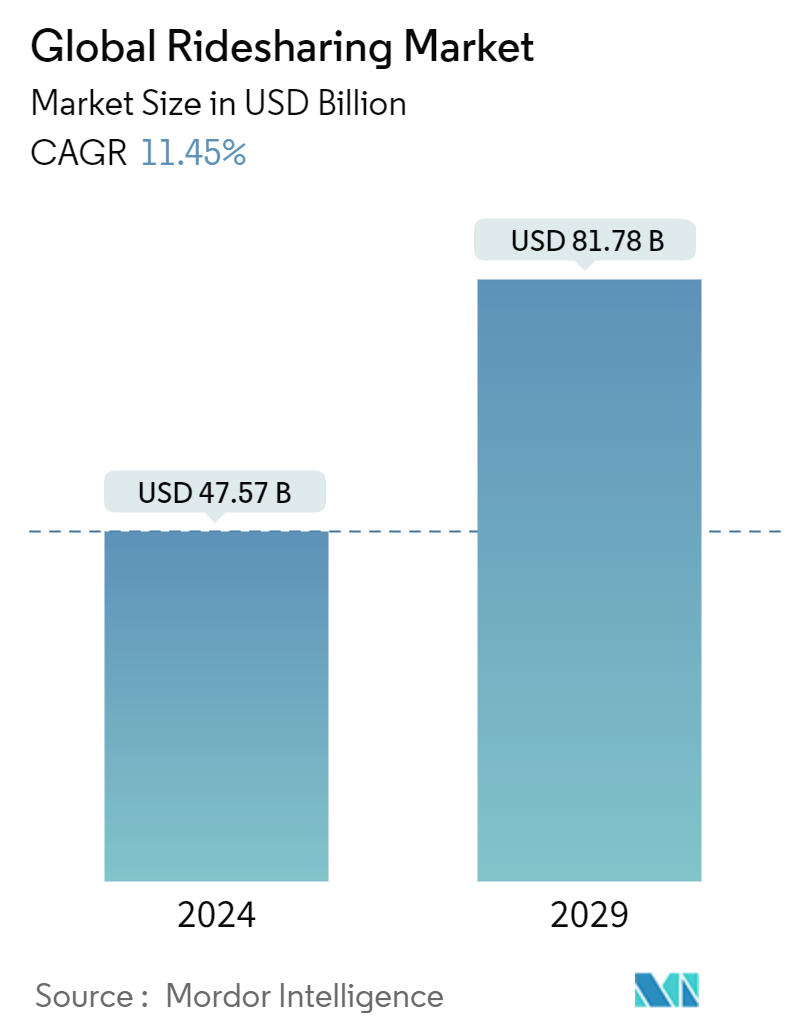| Study Period | 2019 - 2029 |
| Market Size (2024) | USD 47.57 Billion |
| Market Size (2029) | USD 81.78 Billion |
| CAGR (2024 - 2029) | 11.45 % |
| Fastest Growing Market | Asia Pacific |
| Largest Market | Europe |
| Market Concentration | Low |
Major Players*Disclaimer: Major Players sorted in no particular order |
Ridesharing Market Analysis
The Global Ridesharing Market size is estimated at USD 47.57 billion in 2024, and is expected to reach USD 81.78 billion by 2029, growing at a CAGR of 11.45% during the forecast period (2024-2029).
Several factors drive the growth of the ride sharing market, such as rising vehicle ownership costs, environmental concerns prompting a reduction in traffic, and government regulations advocating for ride sharing. These factors are critical drivers of the global surge in ride sharing adoption. These services are favored for their cost-effectiveness and are also anticipated to outpace affordable car ownership.
- Over the past decade, ride sharing has emerged as a global trend, with many individuals opting for it over conventional taxi services. Typically, ride sharing firms utilize GPS tracking to connect potential passengers with drivers via mobile applications or websites. Ride sharing companies can bypass standard licensing and regulatory mandates, unlike traditional taxi services. Factors such as declining car ownership, increasing internet and smartphone penetration, and stringent CO2 reduction targets collectively drive the rising demand for ride sharing services.
- The rise in the number of people commuting to work also propels the demand for ride sharing services. For instance, according to the US Census Bureau, almost 140 million people in the United States routinely commuted to work in 2022. Further, according to Move in Sync, the Employee Commute India 2023 report stated that Mumbai led the way in employee returns to the office, surpassing pre-pandemic levels in December 2022. Following Mumbai, the National Capital Region (NCR) saw a return rate of 92%, Bangalore at 85%, and Hyderabad at 81%. Such a huge number of people commuting and returning to offices would drive the market's growth.
- Globally, the surge in smart device adoption encompassing smartphones and smart wearables coupled with heightened internet data usage has catalyzed the growth of ride sharing services. Accessing ride transport services hinges on internet connectivity. Users leverage internet-enabled smartphone applications to gather information and navigate their rides. V2V communication, navigation, and telematics rely on this connectivity for optimal performance. Smartphone applications bolster security, offering features like driver's name, number, photograph, vehicle identification, route tracing, and historical ride records.
- There is an increase in the number of service providers and application vendors operating in prominent markets, thus creating a competitive space where vendors are forced to offer benefits to consumers at a loss that may not be sustainable over a long period. Once the service provider switches the business plan to turn toward profitability by increasing the prices of the services offered, consumers may switch to newer players offering similar services at competitive prices. Such scenarios are challenging the growth of service providers.
- During robust economic growth, rising disposable incomes often boost ride sharing demand, with individuals more inclined to pay for convenience. Conversely, high employment rates can tighten the supply of drivers, as fewer individuals are available or willing to participate in ridesharing. For multinational ride sharing firms, fluctuating exchange rates can sway profitability. Pricing strategies across diverse markets are crucial in shaping demand, especially if unfavorable currency shifts lead to price hikes.
Ridesharing Industry Segmentation
A ride sharing company, also known as a ride-hailing service, matches passengers with drivers of app-taxis or e-taxis through websites and mobile apps, unlike taxis that can be hailed from a street.
The ride sharing market is defined based on the membership count and overall revenues acquired by the pure-play ride sharing companies that provide different types of services, such as fixed long-distance ridesharing, dynamic (short-distance) ridesharing, and corporate ridesharing. The market scope excludes companies like Uber, Lyft, and Grab (among others) that primarily specialize in providing ride-hailing services, as their key business objective and nature of the engagement between rider and customer is fundamentally different from that of ride-sharing vendors. Additionally, the scope does not include local and informal carpool programs that operate at a very limited scale owing to a lack of credible information on their operations. The analysis is based on the market insights captured through secondary research and the primaries. The market also covers major factors impacting the growth of the market in terms of drivers and restraints.
The ride sharing market is segmented by membership type (fixed ridesharing, dynamic ridesharing, and corporate ridesharing), by service type (web-based, app-based, and web & app-based), and by geography (North America, Europe, Asia Pacific, and the rest of the World). The market sizes and forecasts are provided in terms of value (USD) for all the above segments.
| Fixed Ridesharing |
| Dynamic Ridesharing |
| Corporate Ridesharing |
| Web-Based |
| App-Based |
| Web and App Based |
| North America |
| Europe |
| Asia |
| Australia and New Zealand |
| Latin America |
| Middle East and Africa |
Global Ridesharing Market Size Summary
The global ridesharing market is poised for significant growth, driven by the increasing demand for cost-effective and time-efficient transportation solutions. Factors such as the rising costs of car ownership, environmental concerns, and supportive government regulations are propelling the adoption of ridesharing services worldwide. The market is witnessing a surge in digital network-driven platforms, particularly in regions like Southeast Asia, where inadequate public transportation and growing urban populations are creating a robust demand for affordable mobility options. Despite the challenges posed by the COVID-19 pandemic, which temporarily reduced demand for ridesharing services, the market is expected to rebound as consumers shift towards personal vehicles and ridesharing solutions that offer enhanced safety and convenience.
The ridesharing industry is characterized by intense competition and a fragmented market landscape, with numerous players vying for market share through innovative offerings and strategic partnerships. Companies are increasingly focusing on expanding their user base by introducing new services and leveraging technology to enhance the customer experience. The market is also witnessing collaborations aimed at integrating autonomous vehicles and advanced mobility solutions, further driving its expansion. As urbanization continues to strain transportation infrastructure, initiatives like Mobility as a Service (MaaS) and electric vehicle sharing programs are gaining traction, particularly in Europe and Asia-Pacific. These developments, coupled with the ongoing efforts to reduce carbon emissions and promote sustainable transport, are expected to shape the future trajectory of the ridesharing market.
Global Ridesharing Market Size - Table of Contents
1. MARKET DYNAMICS
-
1.1 Market Drivers
- 1.1.1 Cost Advantage and Increasing Availability of Carpooling/Corporate Pooling Services
- 1.1.2 Incentives and Rebates Provided by Governments in Major Markets
- 1.1.3 Increasing Cost of Vehicle Ownership and Environmental Benefits
-
1.2 Market Challenges
- 1.2.1 Last-mile Connectivity Concerns and Dynamic Nature of the Industry and Increasing Number of Ride Hailing Vendors Poses a Challenge for Existing Operators
- 1.3 Market Opportunties
- 1.4 Parameters for Car-sharing Regulation
- 1.5 Business/Revenue Model Use Cases
2. MARKET SEGMENTATION
-
2.1 By Membership Type
- 2.1.1 Fixed Ridesharing
- 2.1.2 Dynamic Ridesharing
- 2.1.3 Corporate Ridesharing
-
2.2 By Service Type
- 2.2.1 Web-Based
- 2.2.2 App-Based
- 2.2.3 Web and App Based
-
2.3 By Geography***
- 2.3.1 North America
- 2.3.2 Europe
- 2.3.3 Asia
- 2.3.4 Australia and New Zealand
- 2.3.5 Latin America
- 2.3.6 Middle East and Africa
Global Ridesharing Market Research Faqs
How big is the Global Ridesharing Market?
The Global Ridesharing Market size is expected to reach USD 53.02 billion in 2025 and grow at a CAGR of 11.45% to reach USD 91.16 billion by 2030.
What is the current Global Ridesharing Market size?
In 2025, the Global Ridesharing Market size is expected to reach USD 53.02 billion.




